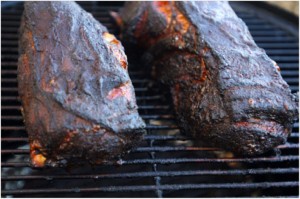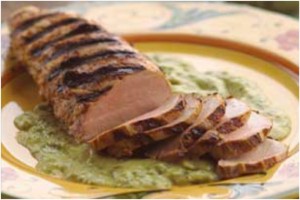Pork has had quite a varying reputation through the years. In the mid-20th century, most pork had to be cooked well done because of the fear of trichinosis. But today pork is fed and raised differently and the meat is safe to eat when cooked properly, with no fear of trichinosis. If the juices run very light pink, the pork is done. The #1 problem with grilling pork is overcooking the pork. Remember, SLIGHTLY PINK PORK IS DONE PORK!
Commercial hogs don't move around as much as cattle do, so the muscles don't have to work as hard and don't use as much oxygen. Less oxygen means less myoglobin, what gives meat it’s read color, so the meat is a lighter color. All natural hogs move around in the field and walk about the land, so their meat is darker red. Pound for pound, pork has more nutrients than chicken. Of course, being lean, it's more difficult to cook pork so it stays tender and juicy.
AVOID BUYING ENHANCED INJECTED PORK! At Joe’s that’s not a problem, but if you’re shopping elsewhere make sure your pork has not been injected with saline, saltwater, or anything else. It actually steams your pork when cooking and if using low and slow methods can make your pork drier. It also gives your pork a salty or “hammy” taste.
Here’s our take on grilling perfect pork:
Pork Seasoning – Pork lends itself to a broader range of seasoning than beef. It does very well with herbs such as rosemary, thyme, sage, mustard seed, and herbs du Provence. It also lends itself well to more traditional soy based meat marinades and even the universal Italian Dressing. Depending on if you’re in the BBQ mood, it also does excellent with a wide array of “rubs” made by combining coarse salt, cumin, paprika, chili powder, brown sugar, etc. If you are using BBQ sauce make sure you add it at the end of your grilling time, or you will burn the sauce onto your pork!
Pork Shoulder/Pork Butt
 Nothing is quite as easy or tasty as slow grilled pork shoulder/butt ready to “pull” for sandwiches. Take your pork shoulder and cut away the fat cap and any pockets of external fat. You are going to cut off the fat at the end of grilling anyway so why not do it now? Unlike a beef brisket, pork shoulder is self -basting and removing the external fat won’t dry out your meat. Instead, it will allow you to expose more meat to the rub, and provide more flavorful dark outside meat called “bark” that people enjoy so much. We like to rub ours with our favorite dark mustard, followed by a good helping of our favorite BBQ rub. When we’re done we set wrap it in plastic wrap and put it in the fridge.
Nothing is quite as easy or tasty as slow grilled pork shoulder/butt ready to “pull” for sandwiches. Take your pork shoulder and cut away the fat cap and any pockets of external fat. You are going to cut off the fat at the end of grilling anyway so why not do it now? Unlike a beef brisket, pork shoulder is self -basting and removing the external fat won’t dry out your meat. Instead, it will allow you to expose more meat to the rub, and provide more flavorful dark outside meat called “bark” that people enjoy so much. We like to rub ours with our favorite dark mustard, followed by a good helping of our favorite BBQ rub. When we’re done we set wrap it in plastic wrap and put it in the fridge.
Prepare your grill for Indirect heat such that you can maintain a temperature of 225-235 degrees. Unlike other meats, it’s OK to put cold pork on the grill so go ahead and take your shoulder straight from the fridge to your grill (removing the wrap of course!). Basically that’s it. Your shoulder will stay in on the indirect side of your grill until it reaches an internal temperature of 190 degrees (warning if you meat seems to “plateau” at 170 degrees or so, don’t worry, leave it and it will get to 190 degrees, have faith!). It needs to get that hot so that the collagen in the pork converts to gelatin. In terms of cooking times, plan on grilling your pork for about 1.5 to 2 hours per trimmed pound of meat.
If you want to turn your pork or baste it (optional and not necessary but the pork will cook more evenly and the bark will soften a bit) take your total cooking time and baste/turn at ¼, ½, and ¾ of the total time. Remove your shoulder from the grill and allow it to rest lightly covered with foil for 30 minutes then pull the meat into strips with your hands or two forks to use for sandwiches!
P ork Loin Roasts or Pork Tenderloin Roasts
ork Loin Roasts or Pork Tenderloin Roasts
It does not matter if your pork loin roast is boneless or bone-in and frenched, the methods for grilling are identical. Season, rub, or marinate your roast as you wish, then sear it on all sides using Direct heat on a 400 degree grill. Then reset your grill to indirect medium/low cooking (medium /low on one side or piled coals on one side, the other side off or no coals).
Place the seared pork on the Indirect side, turning just one, but cooking until the roast reaches an internal temperature of 150 degrees. Remove your pork from the grill and let it rest for 10 minutes before cutting.
Pork Chops
Once again, boneless or bone-in methods are the same. But it does matter if your chops are thin or thick, as the methods are different. Thin Chops – Thin chops should be grilled hot and fast. Don’t step away from your grill, thinner pork chops will cook fast. Preheat your grill to as hot a temperature as it will go. Place the chops on the grill and close the lid for 1 minute. Open the lid and rotate the chops 45 degrees without flipping. Close the lid for another minute. Flip the chops over and close the lid again.
 After a minute rotate the chops 45 degrees and finish them off. With a hot grill and thin chops you will finished them in about 4-5 minutes. Thick Chops – Thick chops need a slower heat to get them cooked without drying them out. Preheat your grill as high as it will go. Put the chops on the grill and close the lid. After one minute open the grill and flip the chops. Close the lid for one minute. Now turn down the heat on your grill to medium (or move the chops to the cooler side of your charcoal grill).
After a minute rotate the chops 45 degrees and finish them off. With a hot grill and thin chops you will finished them in about 4-5 minutes. Thick Chops – Thick chops need a slower heat to get them cooked without drying them out. Preheat your grill as high as it will go. Put the chops on the grill and close the lid. After one minute open the grill and flip the chops. Close the lid for one minute. Now turn down the heat on your grill to medium (or move the chops to the cooler side of your charcoal grill).
Rotate the chops to get your cross hatch marks and let them cook for about 3 more minutes with the lid down. After this time flip the chops over and continue cooking for about 4 more minutes. The finished temperature of your pork chops should be about 150 degrees. Thin chops need no resting time, but you will want to let thick chops rest for 5 minutes or so before eating.
